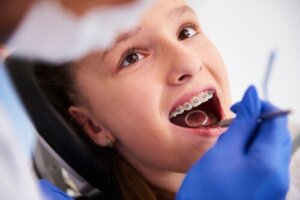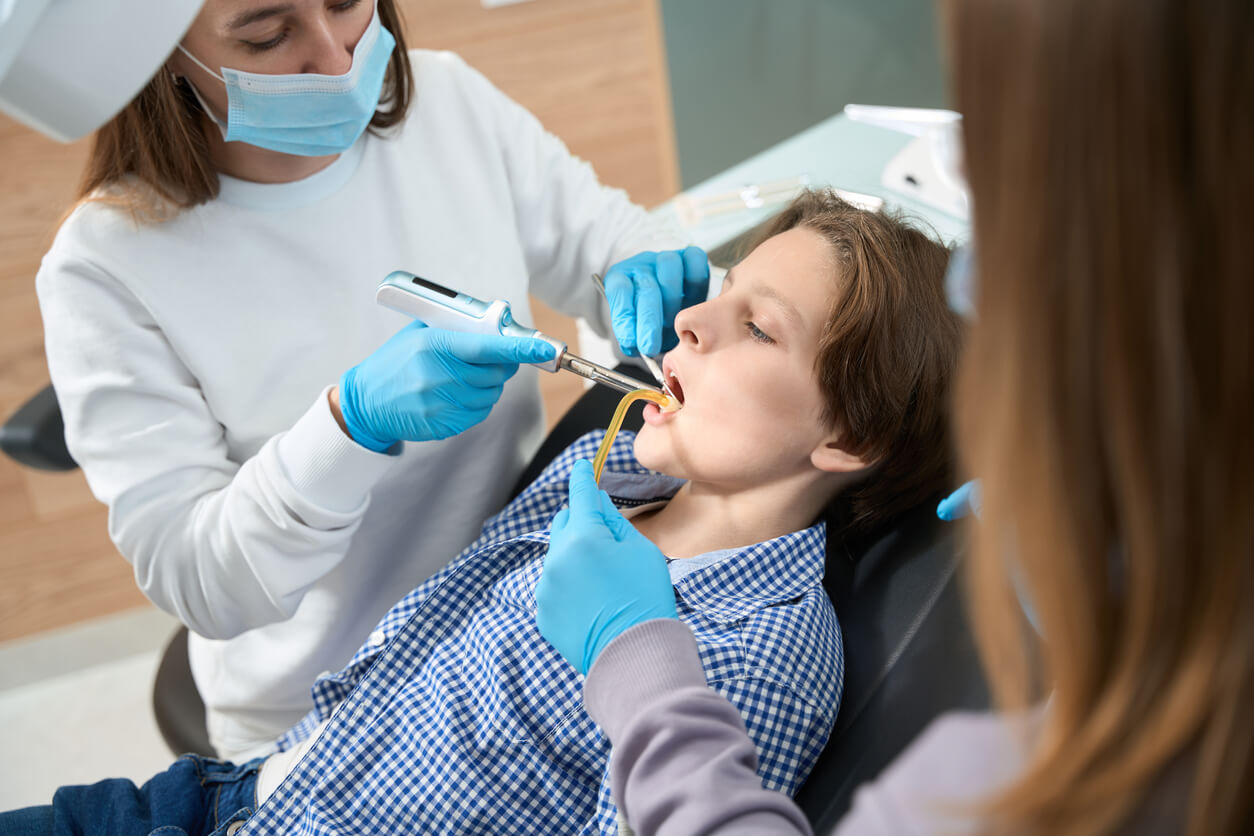Early Orthodontics in Children: Expansion or Tooth Extractions?


Written and verified by the dentist Vanesa Evangelina Buffa
Early orthodontics helps correct bite problems as children grow. It’s a treatment capable of guiding the development of the jaw bones so that they reach an adequate shape and size. During infancy, it’s possible to detect anomalies in the growth of the orofacial structures that cause alterations in occlusion. The first symptoms of bite problems can be evidenced in childhood, and treating them at this stage brings many benefits.
Early orthodontics allows these problems to be addressed before they progress and become complicated. There are different alternatives to solve each of the conditions. For example, when there’s little space in the mouth and teeth are crowded in the arch, expansion or tooth extractions can be used.
In this article, we’ll clarify the benefits of early orthodontics in children and tell you in detail when expansion and interceptive extractions are used.
Early orthodontics in children and its benefits
The Spanish Society of Orthodontics (SEDO) recommends taking children for their first evaluation with the orthodontist when their first permanent molar erupts, which happens at around 6 years of age. At this stage, it’s possible to detect problems in jaw development and treat them early. This is aimed at solving functional and bone growth problems. To do this, special appliances are used to guide, stimulate, or slow down the growth of the jaws.
Early orthodontic treatment in children allows bite problems to be solved as soon as they’re detected. This prevents the disorder from continuing and worsening. In addition, it avoids the consequences that malocclusions can generate in the child, such as problems with eating, chewing, or speaking, and alterations in the appearance of the smile and face. This improves the child’s quality of life and prevents psychosocial difficulties related to malocclusion.

When early orthodontics is used in children
There are several situations in the mouth that can lead the orthodontist to indicate the use of an appliance in childhood. These are the most common problems in children that can be solved with early orthodontics:
- Tooth eruption problems.
- Crossbite: The lower teeth bite on the outside of the upper teeth, opposite of what’s normal.
- Open bite: When the lower teeth don’t make contact with the upper teeth when closing the mouth.
- Ogival palate or very narrow palate.
- Dental crowding.
- Growth problems in the jaws: They’re too big or too small and the relationship between them is compromised.
- Snoring.
- Habits such as thumb sucking, mouth breathing, or sticking out the tongue when swallowing.
Expansion and interceptive dental extractions, possible solutions to a lack of space
When small children have very narrow jaws and the teeth don’t have enough space to align in place, dental crowding appears. Expansion and interceptive dental extractions are the most commonly used options to solve this type of problem.
The choice between one alternative or another depends to a great extent on the amount of space that’s lacking, the age, the particularities of the child, and the professional’s criteria. Below, we’ll tell you what each of these early orthodontic treatments is about.
Expansion
Expansion treatments are intended to widen the upper and lower jaw when they’re very narrow. In general, they’re most often used on the palate, although there are also appliances to stimulate jaw growth.
Expansion of the jaws is achieved through the use of special appliances that stimulate bone growth. Depending on the needs of the case, different types of devices are put in place to allow the oral structures to reach their proper shape and size.
In general, these appliances are made up of two symmetrical components, made of acrylic or metal, joined together by means of a screw. By turning this piece, the parts of the expander begin to separate and exert force on the bones to widen them. By stimulating the growth of the jaws, the teeth have enough space to align in the arch.

Interceptive tooth extractions
Sometimes the orthodontist may recommend the removal of a baby or permanent tooth to gain space. This allows that place in the arch to be used to favor the alignment of the rest of the teeth or even to allow the eruption of some element. In general, it’s best to keep the elements in the mouth, but there are cases in which preserving them prevents achieving a healthy occlusion.
Professionals will always make a thorough study and perform a thorough assessment of the child’s facial profile before recommending this treatment. The decision to use expansion or to resort to extractions will depend on the particular needs of the child.
In addition, there are other situations that may lead a professional to consider tooth extractions as part of early orthodontics in children:
- Severe crowding that can’t be treated with expansion
- Severely destroyed teeth, compromised by cavities or with painful symptomatology
- Very asymmetric bites
- The absence of other teeth in the mouth
The importance of frequent check-ups
Early orthodontics in children can efficiently correct certain malocclusions and avoid their complications. In some cases, it even helps to avoid the need for complex, uncomfortable, and costly procedures in adolescence or adulthood.
Orthodontic treatments are easy to use and are well-accepted by children. Therefore, taking advantage of the growing stage is an excellent strategy to solve bite problems simply and early. Don’t forget to schedule an evaluation with your child’s orthodontist starting at age 6. With regular dental checkups, you can make sure that everything’s going well in your child’s mouth.
Early orthodontics helps correct bite problems as children grow. It’s a treatment capable of guiding the development of the jaw bones so that they reach an adequate shape and size. During infancy, it’s possible to detect anomalies in the growth of the orofacial structures that cause alterations in occlusion. The first symptoms of bite problems can be evidenced in childhood, and treating them at this stage brings many benefits.
Early orthodontics allows these problems to be addressed before they progress and become complicated. There are different alternatives to solve each of the conditions. For example, when there’s little space in the mouth and teeth are crowded in the arch, expansion or tooth extractions can be used.
In this article, we’ll clarify the benefits of early orthodontics in children and tell you in detail when expansion and interceptive extractions are used.
Early orthodontics in children and its benefits
The Spanish Society of Orthodontics (SEDO) recommends taking children for their first evaluation with the orthodontist when their first permanent molar erupts, which happens at around 6 years of age. At this stage, it’s possible to detect problems in jaw development and treat them early. This is aimed at solving functional and bone growth problems. To do this, special appliances are used to guide, stimulate, or slow down the growth of the jaws.
Early orthodontic treatment in children allows bite problems to be solved as soon as they’re detected. This prevents the disorder from continuing and worsening. In addition, it avoids the consequences that malocclusions can generate in the child, such as problems with eating, chewing, or speaking, and alterations in the appearance of the smile and face. This improves the child’s quality of life and prevents psychosocial difficulties related to malocclusion.

When early orthodontics is used in children
There are several situations in the mouth that can lead the orthodontist to indicate the use of an appliance in childhood. These are the most common problems in children that can be solved with early orthodontics:
- Tooth eruption problems.
- Crossbite: The lower teeth bite on the outside of the upper teeth, opposite of what’s normal.
- Open bite: When the lower teeth don’t make contact with the upper teeth when closing the mouth.
- Ogival palate or very narrow palate.
- Dental crowding.
- Growth problems in the jaws: They’re too big or too small and the relationship between them is compromised.
- Snoring.
- Habits such as thumb sucking, mouth breathing, or sticking out the tongue when swallowing.
Expansion and interceptive dental extractions, possible solutions to a lack of space
When small children have very narrow jaws and the teeth don’t have enough space to align in place, dental crowding appears. Expansion and interceptive dental extractions are the most commonly used options to solve this type of problem.
The choice between one alternative or another depends to a great extent on the amount of space that’s lacking, the age, the particularities of the child, and the professional’s criteria. Below, we’ll tell you what each of these early orthodontic treatments is about.
Expansion
Expansion treatments are intended to widen the upper and lower jaw when they’re very narrow. In general, they’re most often used on the palate, although there are also appliances to stimulate jaw growth.
Expansion of the jaws is achieved through the use of special appliances that stimulate bone growth. Depending on the needs of the case, different types of devices are put in place to allow the oral structures to reach their proper shape and size.
In general, these appliances are made up of two symmetrical components, made of acrylic or metal, joined together by means of a screw. By turning this piece, the parts of the expander begin to separate and exert force on the bones to widen them. By stimulating the growth of the jaws, the teeth have enough space to align in the arch.

Interceptive tooth extractions
Sometimes the orthodontist may recommend the removal of a baby or permanent tooth to gain space. This allows that place in the arch to be used to favor the alignment of the rest of the teeth or even to allow the eruption of some element. In general, it’s best to keep the elements in the mouth, but there are cases in which preserving them prevents achieving a healthy occlusion.
Professionals will always make a thorough study and perform a thorough assessment of the child’s facial profile before recommending this treatment. The decision to use expansion or to resort to extractions will depend on the particular needs of the child.
In addition, there are other situations that may lead a professional to consider tooth extractions as part of early orthodontics in children:
- Severe crowding that can’t be treated with expansion
- Severely destroyed teeth, compromised by cavities or with painful symptomatology
- Very asymmetric bites
- The absence of other teeth in the mouth
The importance of frequent check-ups
Early orthodontics in children can efficiently correct certain malocclusions and avoid their complications. In some cases, it even helps to avoid the need for complex, uncomfortable, and costly procedures in adolescence or adulthood.
Orthodontic treatments are easy to use and are well-accepted by children. Therefore, taking advantage of the growing stage is an excellent strategy to solve bite problems simply and early. Don’t forget to schedule an evaluation with your child’s orthodontist starting at age 6. With regular dental checkups, you can make sure that everything’s going well in your child’s mouth.
All cited sources were thoroughly reviewed by our team to ensure their quality, reliability, currency, and validity. The bibliography of this article was considered reliable and of academic or scientific accuracy.
- Pritchard, B. T. Maxillary expansion or bicuspid extraction: A case study in orthodontics.
- Mapare, S., Mundada, R., Karra, A., Agrawal, S., Mahajan, S. B., & Tadawalkar, A. (2021). Extraction or nonextraction in orthodontic cases: A review. Journal of Pharmacy & Bioallied Sciences, 13(Suppl 1), S2.
- FEREGRINO VEJAR, L. O. U. R. D. E. S., & GUTIERREZ ROJO, J. F. (2016). Percepción y efectos psicosociales de las maloclusiones. CONACYT.
- Vallejo Izquierdo, K. K. (2022). Efectos del uso de los aparatos de expansión rápida maxilar Hyrax y Haas sobre los defectos dentofaciales transversales y la respiración en niños en etapa de crecimiento. Revisión Bibliográfica.
- Chavarría Martínez, J. M. (2018). Beneficios de las placas de expansión bilateral y extracción seriada en apiñamiento dental moderado (Bachelor’s thesis, Universidad de Guayaquil. Facultad Piloto de Odontología).
- Carrasco-Sierra, M., Mendoza-Castro, A. M., & Andrade-Vera, F. M. (2018). Implementación de la ortodoncia interceptiva. Dominio de las Ciencias, 4(1), 332-340.
- Perero Vilela, B. J. (2019). Tratamiento ortopédico del apiñamiento dental clase ii en niño de 10 años (Bachelor’s thesis, Universidad de Guayaquil. Facultad Piloto de Odontología).
This text is provided for informational purposes only and does not replace consultation with a professional. If in doubt, consult your specialist.








